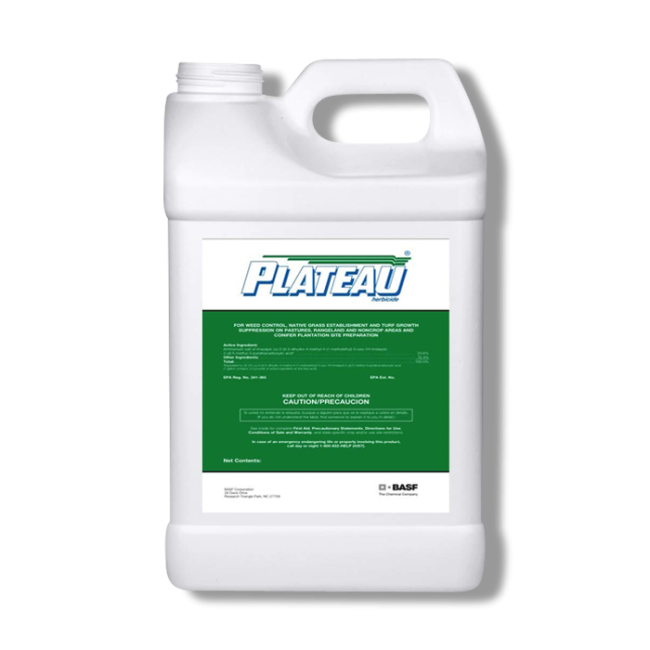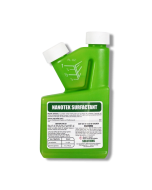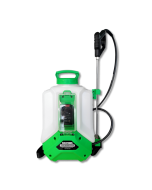Gain access to personalized product screening, the best pricing, rewards, and more!






application2
Plateau Herbicide For Prairie Grass Management
Plateau Herbicide is a broad, flexible post-emergent herbicide for treating weeds on roadsides, prairies, and rangelands. It is especially effective against bromegrass, tall fescue, and Bahiagrass, helping to reduce mowings.
01/02/26
Plateau Herbicide, manufactured by BASF, is a powerful and versatile herbicide popular for vegetation management on roadsides, prairies, and rangelands.
This emulsifiable concentrate formulation can be applied using various methods to control a broad spectrum of pest plants and annual grasses. Plateau has even been approved for use in federal reserves.
Plateau Herbicide is mainly used to treat bindweed, cheatgrass, Johnsongrass, leafy spurge, tall fescue, and other common problem weeds.
Tools Needed
You will need a sprayer either for small-scale or large-scale applications.
When applying around the home or on a small scale, we suggest using a pump sprayer, a backpack sprayer, or a hose-end sprayer. For large-scale use, such as over pastures or rangeland, you can apply plateau with a spray rig or power sprayer.
This product may require a nonionic surfactant, methylated seed oil (MSO), vegetable oil concentrate, silicone-based surfactant, or fertilizer/surfactant blends.
How To Use
- Step 1: Identify the areas you plan to apply the product to, Identify what pest plants are in the area, and measure the square footage of the treatment area. This will determine how much product needs to be mixed and applied. To find square footage, measure the length and width of the treatment area in feet, then multiply them together (length X width = square footage). For acreage, divide the square footage by one acre (square footage / 43,560 sq. ft. = acre). The application rate varies depending on where it is being sprayed and what is being treated. The general rate is 4 to 8 oz. of Plateau Herbicide per acre in at least 5 or more gallons of water. For ground spot treatments, the rate is 0.3 to 1.9 oz. of product per gallon of water. Refer to the product label for specific application rates and restrictions. Do not exceed 12 oz. of this product per acre in one year.
- Step 2: Fill your sprayer with half the water, add the proper amount of product, and then pour in the remaining half. Ensure that the product is thoroughly agitated in the tank before application. It would be best to add the nonionic surfactant when you add the Plateau Herbicide to the mixture. Thoroughly mix the product in water, then add the adjuvant.
- Step 3: Apply the product to the desired area, spraying the target weed until it is wet but not to the point of runoff. Use a fan spray nozzle setting for even coverage. Reapply as needed, according to label guidelines.
Where to Apply
Plateau Herbicide can be applied to pastures, rangelands, Federal Conservation Reserve Program (CRP) land, and noncropland areas, including those that may be grazed or cut for hay.
Examples of non-cropland areas include but are not limited to railroad, utility, pipeline, and highway rights-of-way, railroad crossings, utility plant sites, petroleum tank farms, pumping installations, non-agriculture fence rows, storage areas, non-irrigation ditch banks, prairie sites, airports, industrial turf, golf courses, recreational and non-residential turf, and other similar areas.
This product may be used for the release of bermudagrass, bahiagrass, smooth bromegrass, wheatgrass, wildtype common Kentucky bluegrass, native prairie grass, wildflowers, crown vetch, other grasses, and certain legumes. This product can also be used for weed control during the establishment of native prairie grasses and other grasses. As well as for conifer plantation site preparation.
Do not apply this product to residential lawns.
When to Apply
Apply Plateau Herbicide in areas where plant pests affect the desired plant growth in rangelands. You can even apply when weeds crowd out your hay crops.
It may also be applied in the dormant or growing season for weed control. Tolerance of desirable grass species to Plateau Herbicide may be reduced when grasses are stressed due to insect damage, disease, environmental conditions, shade, poorly drained soils, or other causes.
Do not apply this product when rainfall is forecasted 48 hours after application. Rainfall within 1 hour after Plateau Herbicide application may reduce weed control.
Safety Information
Plateau Herbicide is safe to use around children and pets when applied according to the product label instructions. Always wear the proper personal protective equipment (PPE) when mixing and applying this product.
Do not cut the treated area for hay within seven days after treatment.
Keep people and pets out of treated areas until the spray completely dries.
Special Considerations
Use higher rates on heavier soils and lower rates on sandy soils and drier sites. In most cases, this product must be mixed with an adjuvant, so read the label for proper instructions regarding your plant type and the desired application method.
When making applications around desirable trees or ornamental plants, small areas should be tested to determine the tolerance of a particular species to soil and/or foliar applications of Plateau Herbicide.
Depending on the turf type being treated, some yellowing may occur with applications during the growing season. The yellowing will usually disappear in 2 to 4 weeks, depending on weather conditions.
| Restricted Use | No |
|---|---|
| Shipping Restrictions | CA |
| Availability | Online |
| Signal Word | CAUTION |
| Keith's Pro Tip | "When making applications of Plateau around desirable trees or ornamental plants, small areas should be tested to determine the tolerance of a particular species to soil and foliar applications." |
| Target Pests Multi | Annual Fleabane, Annual Italian Ryegrass, Annual Ryegrass, Annual Stinkgrass, Baby's Breath, Bahiagrass, Barnyardgrass, Blue Vervain, Bristly Houndstongue, Bristly Starbur, Broadleaf Signalgrass, Buffalobur, Bull Thistle, Bur Buttercup, Bur Clover, Buttercup, Carolina Geranium, Catchweed Bedstraw, Cheat, Chickweed, Cocklebur, Coffee Senna, Common Chickweed, Common Cocklebur, Common Cornsalad, Common Lambsquarters, Common Purslane, Common Ragweed, Common Teasel, Crabgrass, Cranesbill Geranium, Crowfootgrass, Curly Dock, Cypressvine Morningglory, Dallisgrass, Dalmation Toadflax, Dandelion, Downy Brome, Entireleaf Morningglory, Fall Panicum, Fescue, Fiddleneck, Field Bindweed, Fleabane, Florida Bedstraw, Florida Beggarweed, Florida Pusley, Foxtail, Garlic Mustard, Geranium, Giant Foxtail, Giant Ragweed, Goatgrass, Golden Crownbeard, Goosegrass, Green Foxtail, Ground Cherry, Hairy Crabgrass, Hairy Indigo, Halogeton, Henbit, Houndstongue, Itchgrass, Ivyleaf Morningglory, Japanese Stiltgrass, Jimsonweed, Johnsongrass, Jointed Goatgrass, Knotroot Foxtail, Kochia, Ladysthumb, Large Crabgrass, Leafy Spurge, Little Barley, Marsh Bedstraw, Medusahead, Musk Thistle, Narrowleaf Plantain, Paspalum, Pennsylvania Smartweed, Perennial Pepperweed, Perennial Ryegrass, Pigweed, Pitted Morningglory, Platt Thistle, Poison Hemlock, Prickly Sida, Prostrate Vevain, Prostrate_Knotweed, Puncture Vine, Purple Nutsedge, Purple Robust Foxtail, Ragweed, Reed Canarygrass, Rhizome Johnsongrass, Rush, Russian Knapweed, Russian Thistle, Sandbur, Sedge, Seedling Johnsongrass, Shattercane, Sicklepod, Signalgrass, Smallflower Morningglory, Smartweed, Smooth Crabgrass, Smutgrass, Spotted Spurge, Spurge Flax, Spurred Anoda, Squirrel Tail Barley, Sunflower, Swamp, Swamp Smartweed, Tall Dropseed, Tall Fescue, Tall Morningglory, Tansy Mustard, Texas Panicum, Thistle, Toothed Spurge, Torpedograss, Vaseygrass, Velvetleaf, Western Ragweed, Whitetop, Wild Garlic, Wild Morning-glory, Wild Mustard, Wild Oats, Wild Onion, Wild Poinsetta, Wild Radish, Wild Sunflower, Willowherb, Yellow Foxtail, Yellow Rocket, Yellow_Nutsedge, Yellow_Woodsorrel |
| Time to Kill | You will begin to see wilting 2-3 days after treatment, and the weeds should be dead after 2 weeks. Some reapplication may be required. |
| Chemical Type | Herbicide |
| Formulation | Emulsifiable Concentrate (EC) |
| Application Methods | Drench Treatment |
| Product Drawbacks | This product is not meant for residential weed control. |
| Active Ingredient | 23.6 % ammonium salt of imazapic. |
| Application Equipment | Backpack Sprayer, Gloves, Hose End Sprayer, Pump Sprayer, Respirator Mask |
| Mix Rate | This product should be applied at a rate of 2-12 oz per acre of land. The amount of water needed varies depending on application method. For more specific application rates please refer to the label. |
| Use Sites | Outdoors |
| Yield | A one gallon bottle of product can treat anywhere from 10 - 64 acres of land. |
| EPA Registration No. | 241-365 |
| Shelf Life | This product will last up to 2 years when stored in a cool, dry location. |
| Comparable Products | Patch Pro, Aligare Picloram P+D |
| Children or pets? | No |
| Property Characteristics | Grazing Animals |
| Availability | Online |
| Restricted Use | No |
| Brand | BASF |
| Keith's Pro Tips | "When making applications of Plateau around desirable trees or ornamental plants, small areas should be tested to determine the tolerance of a particular species to soil and foliar applications." |
| Product Drawbacks | This product is not meant for residential weed control. |
| Target Pests | Annual Fleabane, Annual Ryegrass, Baby's breath, Bahiagrass, Barnyardgrass, BlueVervain, Bristly Houndstongue, Bristly Starbur, Broadleaf Signalgrass, Buffalobur, Bull Thistle, Bur Buttercup, Burclover, Carolina Geranium, Catchweed Bedstraw, Cathcweed Bedstraw, Cheat, Coffee Senna, Common chickweed, Common Cocklebur, Common Lambsquarters, Common Purslane, common teasel, Crabgrass, Cranesbill Geranium, Crowfootgrass, curly Dock, Dallisgrass, Dalmatian Toadflax, Dalmation Toadlfax, Dandelion, Downey Brome, Downy Brome, Fall Panicum, Field Bindweed, Florida Bedstraw, Florida Beggarweed, Florida Pusley, Foxtail, Garlic Mustard, Giant Foxtail, Golden Crownbeard, Goosegrass, Green Foxtail, Ground Cherry, Hairy Indigo, Halogeton, Henbit, Itchgrass, Japanese Stiltgrass, Jimsonweed, Johnsongrass, jointed Goatgrass, Knotroot Foxtail, Kochia, Ladysthumb, Large Crabgrass, Leafy Spurge, Little Barley, Marsh Bedstraw, Medusahead, Moringglory, Morningglory, Musk Thistle, Narrowleaf Plantain, Paspalum spp, Perennial Pepperweed, Pigweed, Platt Thistle, Poison Hemlock, Prickly Sida, Prostrate Knotweed, Prostrate Vervain, Puncture Vine, Purple Nutsedge, Purple Robust Foxtail, Queen Anne's Lace, Ragweed, Reed Canarygrass, Russian Knapweed, Russian Thistle, Sandbur, Sedge, Shattercane, Sicklepod, Smartweed, Smooth Crabgrass, Smutgrass, Spurge, Spurge Flax, Spurred Anoda, Squirrel Tail Barley, Sunflower, Swamp, Tall Dropseed, Tall Fescue, Tansymustard, Torpedograss, Vaseygrass, Velvetleaf, Whitetop, Wild Garlic, Wild Mustard, Wild Oats, Wild Onion, Wild Poinsetta, Wild Raddish, Willowherb, Yellow Foxtail, Yellow Nutsedge, Yellow Rocket, and Yellow Woodsorrel. |
| Application Equipment | Backpack Sprayer, Gloves, Hose End Sprayer, Pump Sprayer, Respirator Mask |
| Application Methods | Drench Treatment |
| Active Ingredient | 23.6 % ammonium salt of imazapic. |
| Product Type | Herbicide |
| Formulation | Emulsifiable Concentrate (EC) |
| Application Rate | This product should be applied at a rate of 2-12 oz per acre of land. The amount of water needed varies depending on application method. For more specific application rates please refer to the label. |
| Shelf Life | This product will last up to 2 years when stored in a cool, dry location. |
| Yield | A one gallon bottle of product can treat anywhere from 10 - 64 acres of land. |
| Use Sites | Outdoors |
| Time to Kill | You will begin to see wilting 2-3 days after treatment, and the weeds should be dead after 2 weeks. Some reapplication may be required. |
| Comparable Products | Patch Pro, Aligare Picloram P+D |
| Incompatible Home Siding | Brick, Hardie Plank, Stone Veneer, Stucco, Wood, Vinyl |
| EPA Registration # | 241-365 |
*Price does not include freight. We guarantee our rate plus shipping will be less than anyone else's price.










